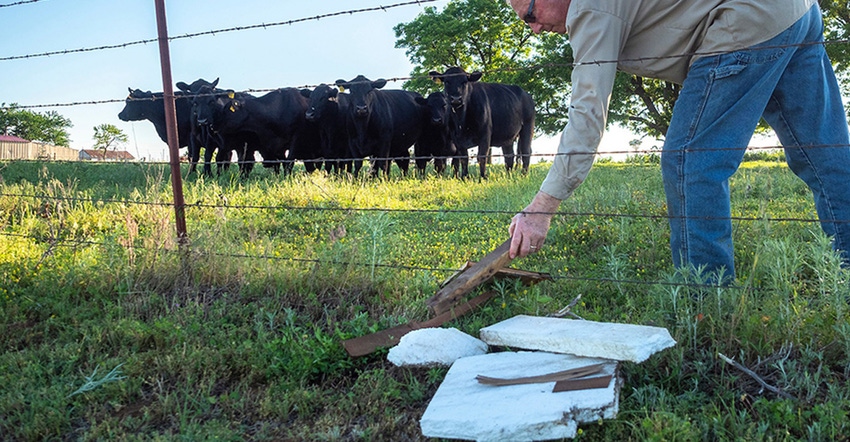Following windy storms, cattle producers are encouraged to remove debris to avoid hardware disease.

Cattle will eat just about anything that looks interesting in the pasture, so following strong wind-weather events, producers are encouraged to remove debris from their pastures, said Oklahoma State University experts.
Insulation and plastic bags, for example, can cause bloat, impaction, and gastrointestinal problems when consumed, including possible hemorrhaging of the rumen, said Dr. Barry Whitworth, OSU Extension veterinarian and food animal quality and health specialist.
“Nails and other small pieces of metal can cause what is often called hardware disease, health problems associated with the consumption of metal,” he said. “The most common source of hardware disease is baling wire or similar small objects that are consumed along with forage.”
Primary concerns are not only the cattle eating bits of metal directly but that items will be picked up during the baling process and included with feed hay later.
Whitworth said a single piece of baling wire consumed with forage or hay will drop down into the reticulum or first stomach where it potentially can pierce the heart.
Other problems sometimes associated with hardware disease are the shutting down of the rumen, depression, acute pain and decreased milk production.
“Cattle producers may want to consider using rumen magnets given the increased amount of metal debris potentially strewn across pastures after tornadoes or storms with sustained high winds,” said Dr. Rosslyn Biggs, OSU Extension veterinarian and director of continuing education for the university’s College of Veterinary Medicine.
Rumen magnets attract and capture fine metal material before it damages an animal’s rumen and reticulum. Local large-animal veterinarians should have information on rumen magnets, including associated costs and availability, Biggs said.
Insulation and plastic debris can present a greater challenge because tiny pieces can be easily overlooked during cleanup. Any indigestible foreign material eaten by cattle can cause blockage in the digestive system. If an animal eats enough small pieces of insulation during grazing or in hay or other feed, it could bind together and create a large mass that could block the digestive tract and cause serious, even fatal, problems.
OSU experts recommend producers collect and remove larger pieces of insulation and plastic and to keep watch for animals exhibiting symptoms of related health problems. Signs may include irritation, vomiting, diarrhea, or stomach discomfort. Producers should contact their local veterinarian immediately if such symptoms are present.
“The local veterinarian will treat on a case-by-case basis,” Biggs said. “This might mean using a treatment with laxatives, mineral oil, fluid therapy or, in appropriate cases, surgery.”
Nails and other sharp metal objects of various sizes also can result in puncture wounds and cuts in the feet and legs of livestock. Often these metal objects have been carried by wind or washed into water holes, ponds, or other areas. If an animal is lame for more than one or two days and the lameness continues to worsen, it should be examined by a veterinarian, Biggs and Whitworth said.
Oklahoma is typically the nation’s fourth- or fifth-leading producer of cattle annually, according to USDA National Agricultural Statistics Service data.
Source: is OSU, which is solely responsible for the information provided and is wholly owned by the source. Informa Business Media and all its subsidiaries are not responsible for any of the content contained in this information asset.
About the Author(s)
You May Also Like



